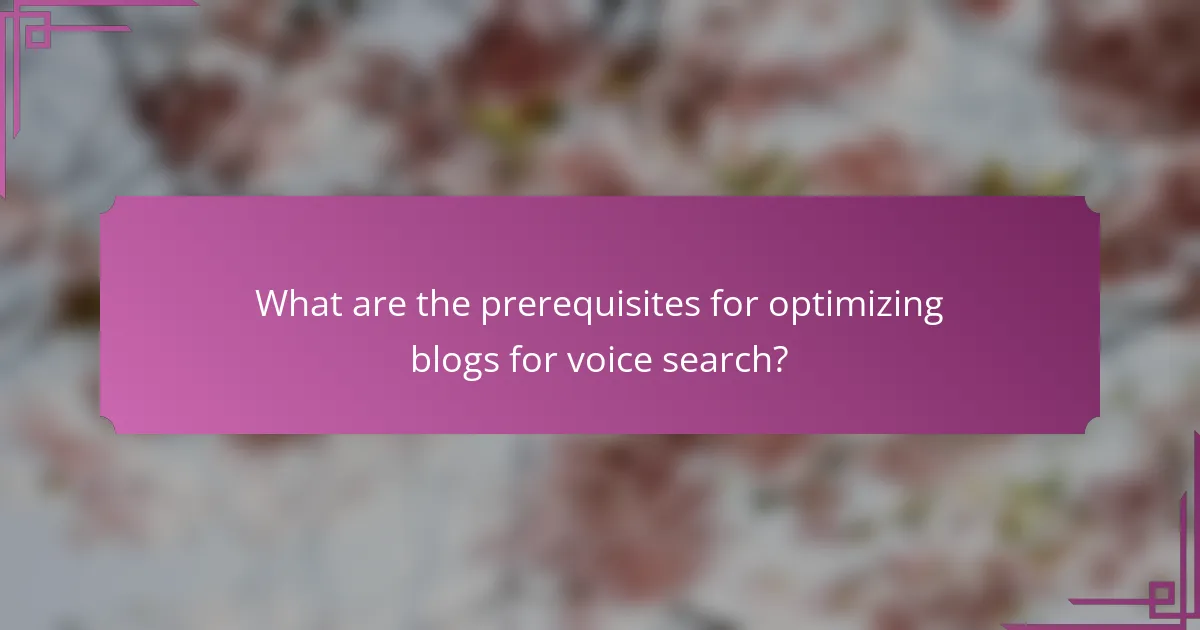In the evolving landscape of digital content, voice search is transforming the way bloggers approach their writing. By adopting a conversational tone and prioritizing user intent, bloggers can create engaging content that not only resonates with their audience but also improves search visibility. Additionally, optimizing for voice search through natural language and long-tail keywords, alongside enhancing user experience, can significantly boost blog performance and audience retention.

How can voice search enhance blogging ideas?
Voice search can significantly enhance blogging ideas by encouraging a more conversational tone and focusing on user intent. This shift allows bloggers to create content that resonates better with their audience, ultimately driving engagement and improving visibility in search results.
Increased engagement through conversational content
Creating conversational content is essential for engaging users who utilize voice search. This means using natural language and phrasing that mimics how people speak, rather than formal or complex language. For example, instead of asking, “What are the benefits of voice search optimization?” a blog post could address the question as, “How does voice search help my blog?”
To enhance engagement, consider incorporating questions and answers that reflect common queries. This approach not only makes the content more relatable but also encourages readers to interact with it, leading to longer time spent on the page.
Higher visibility in search results
Voice search can lead to higher visibility in search results by optimizing for featured snippets and local searches. Many voice searches are location-based, so including local keywords and phrases can help your blog rank better. For instance, if your blog focuses on restaurants, using terms like “best pizza in [city]” can attract local traffic.
Additionally, focusing on long-tail keywords that align with how people verbally ask questions can improve your chances of being featured in voice search results. Aim for keywords that are more conversational and specific, as these often yield better results than generic terms.
Improved user experience with quick answers
Voice search enhances user experience by providing quick and concise answers to queries. Users expect immediate results, so structuring your content to deliver information quickly is crucial. Consider using bullet points or numbered lists to present key information clearly and succinctly.
To optimize for quick answers, ensure your blog posts are well-organized and that the most important information appears early in the content. This not only caters to voice search users but also benefits all readers looking for efficient information retrieval.

What are effective optimization strategies for voice search?
Effective optimization strategies for voice search include focusing on natural language, using long-tail keywords, and enhancing local SEO. These approaches help ensure that content is easily discoverable and relevant to users’ spoken queries.
Utilizing long-tail keywords
Long-tail keywords are phrases that are typically three or more words long, reflecting how people naturally speak. For voice search, these keywords are crucial as they align with conversational queries. For example, instead of targeting “pizza,” consider “best pizza delivery near me.”
To effectively utilize long-tail keywords, conduct research using tools like Google Keyword Planner or Answer the Public. Aim for keywords that have lower competition but higher relevance to your audience’s questions.
Implementing structured data
Structured data helps search engines understand the context of your content, making it easier to provide relevant answers to voice queries. By using schema markup, you can enhance your website’s visibility in search results. For instance, adding structured data for FAQs can improve your chances of appearing in voice search results.
To implement structured data, use Google’s Structured Data Markup Helper to create the necessary code. Ensure that your markup is valid by testing it with Google’s Rich Results Test tool before deploying it on your site.
Focusing on local SEO
Local SEO is particularly important for voice search, as many users seek immediate, location-based information. Optimize your Google My Business listing and ensure your name, address, and phone number (NAP) are consistent across all platforms. This helps improve your visibility for local queries.
Consider adding location-specific keywords to your content, such as “best coffee shop in Boston.” Additionally, encourage customer reviews, as they can enhance your local search rankings and provide social proof to potential customers.

How does user experience impact blog performance?
User experience (UX) significantly affects blog performance by influencing visitor engagement and retention. A positive UX leads to longer time spent on the site, lower bounce rates, and ultimately better search engine rankings.
Lower bounce rates with intuitive navigation
Intuitive navigation helps users find the content they seek quickly, reducing bounce rates. A well-structured menu, clear categories, and a search function can guide visitors seamlessly through the blog.
Consider implementing a breadcrumb trail or sticky navigation to enhance usability. Aim for a loading time under three seconds to keep users from leaving before they even explore your content.
Higher conversion rates through engaging design
Engaging design captures attention and encourages visitors to take action, leading to higher conversion rates. Use visually appealing layouts, high-quality images, and consistent branding to create a memorable experience.
Incorporate call-to-action buttons that stand out but fit naturally within the design. Test different placements and colors to determine what resonates best with your audience, as small changes can lead to significant improvements in conversion rates.

What tools can optimize voice search for blogs?
To enhance voice search optimization for blogs, several tools can provide valuable insights and content ideas. Utilizing these tools effectively can improve your blog’s visibility and user engagement through voice-activated searches.
Google Search Console for keyword insights
Google Search Console is essential for understanding which keywords drive traffic to your blog. It provides data on search queries, click-through rates, and impressions, allowing you to identify high-performing keywords that are relevant to voice search.
Focus on long-tail keywords, as these are more commonly used in voice queries. Regularly review your performance metrics to adjust your content strategy based on what users are searching for, ensuring your blog remains aligned with voice search trends.
AnswerThePublic for content ideas
AnswerThePublic is a powerful tool for generating content ideas based on real user questions and queries. By entering a keyword related to your blog, you can uncover a variety of questions that people are asking, which can guide your content creation process.
Use the insights from AnswerThePublic to create blog posts that directly answer these questions. This approach not only enhances your content’s relevance but also aligns it with the natural language used in voice searches, improving your chances of being featured in voice search results.

What are the prerequisites for optimizing blogs for voice search?
To optimize blogs for voice search, focus on understanding user intent, using natural language, and ensuring mobile-friendliness. These elements enhance visibility and improve user experience, making it easier for voice assistants to deliver relevant content.
Understanding user intent
Understanding user intent is crucial for optimizing blogs for voice search. Users typically ask questions or make requests that reflect their needs, so identifying common queries related to your content is essential. Use tools like Google’s Keyword Planner or Answer the Public to discover popular voice search phrases.
Consider the context in which users might engage with voice search. For instance, someone might ask, “What are the best restaurants nearby?” when they are out and about. Tailor your blog content to answer these specific questions directly and succinctly.
Analyzing competitor strategies
Analyzing competitor strategies helps you identify gaps in your own content and discover effective optimization techniques. Look at how competitors rank for voice search queries and what keywords they target. Tools like SEMrush or Ahrefs can provide insights into their keyword strategies and content performance.
Evaluate the structure and format of your competitors’ content. Are they using FAQs, bullet points, or concise paragraphs? Adopting similar strategies can enhance your blog’s chances of being featured in voice search results. Focus on clarity and brevity to align with the conversational nature of voice queries.

How can blogs adapt to emerging voice search trends?
Blogs can adapt to emerging voice search trends by optimizing content for conversational queries and focusing on user intent. This involves using natural language and structured data to enhance visibility in voice search results.
Incorporating AI-driven content
AI-driven content can help blogs create more relevant and engaging articles tailored for voice search. By leveraging natural language processing, AI tools can analyze user queries and suggest topics or keywords that align with common voice search patterns.
Consider using AI to generate FAQs or conversational snippets that directly answer potential voice queries. This approach not only improves user experience but also increases the chances of appearing in featured snippets, which are often read aloud by voice assistants.
Utilizing voice-activated devices
To effectively utilize voice-activated devices, blogs should ensure their content is easily accessible and optimized for voice search. This includes structuring content with clear headings, concise answers, and bullet points that facilitate quick comprehension.
Additionally, testing how your blog performs on popular voice-activated devices can provide insights into user interactions. Regularly updating content based on voice search trends and user feedback will help maintain relevance and improve overall user experience.

What are the future trends in voice search optimization?
Future trends in voice search optimization focus on enhancing user experience and adapting to evolving technology. As voice search becomes more prevalent, businesses must prioritize conversational keywords and local optimization to stay competitive.
Increased use of natural language processing
Natural language processing (NLP) is becoming increasingly sophisticated, allowing voice search systems to understand context and nuances better. This shift means that content must be tailored to reflect natural speech patterns, making it essential for businesses to incorporate long-tail keywords and phrases that users are likely to speak.
For instance, instead of optimizing for “best pizza,” consider phrases like “where can I find the best pizza near me?” This approach aligns with how people naturally ask questions, improving the chances of appearing in voice search results.
Focus on local SEO
Local SEO is critical for voice search, as users often seek immediate answers related to their vicinity. Businesses should ensure their Google My Business listings are up-to-date and optimized with relevant keywords that reflect local intent.
Utilizing structured data markup can also enhance visibility in local searches. For example, including location-specific details in your content can help search engines deliver more accurate results to users searching for services nearby.
Emphasis on user experience
User experience (UX) plays a vital role in voice search optimization. Websites must load quickly and provide clear, concise information to cater to voice search users who expect immediate answers. A seamless UX can significantly impact how users interact with your content.
To enhance UX, consider implementing mobile-friendly designs and ensuring that your content is easily accessible. Avoid cluttered layouts and focus on delivering straightforward answers to common queries, which can improve engagement and retention rates.


